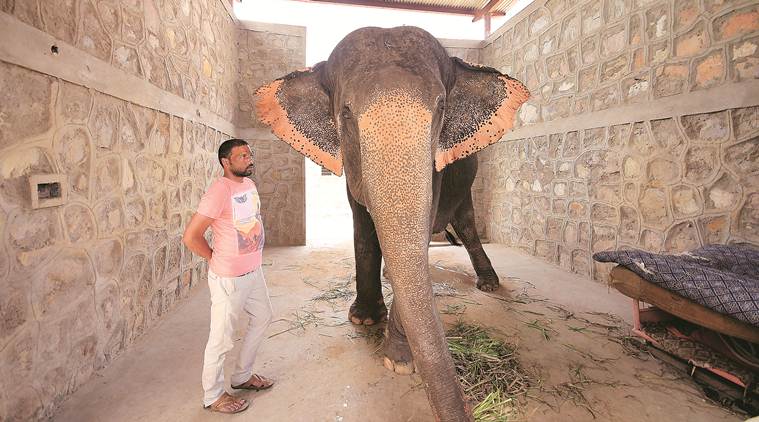 Shafiq with his elephant ‘Majani’, one of the 10 at Haathi Gaon diagnosed with TB and grounded. (Express Photo: Rohit Jain Paras)
Shafiq with his elephant ‘Majani’, one of the 10 at Haathi Gaon diagnosed with TB and grounded. (Express Photo: Rohit Jain Paras)
After a long, searing summer, it finally rained last night. The wet soil is strewn with half-eaten pieces of sugarcane, and marked with large footprints and faint signs of trunks that brushed against the ground. A row of droppings shows the path leading up to the enclosures housing elephants in Jaipur’s Haathi Gaon.
On most mornings, these enclosures are empty. But these are not most mornings, as Shafiq Khan, standing besides his elephant, the 35-year-old ‘Majani’, will tell you.
It’s been more than a fortnight since Majani’s days of ferrying tourists up the steep, winding path to the city’s Amer Fort came to a halt. Having done the climb with Majani, or ‘Elephant No. 55’, almost every day for the past 18 years, ever since the family acquired her from Assam, Shafiq asks: “Does my elephant look ill to you?”
In a recent report, the Animal Welfare Board of India (AWBI) said 10 elephants of Haathi Gaon, including Majani, had been diagnosed with tuberculosis. The report also found that 19 elephants were blind in either one eye or both, while all had foot problems.
The AWBI had sent an inspection team to Jaipur after custodians of the elephants applied to it for registration of their animals under the Performing Animals (Registration) Amendment Rules, 2001.
Following its report, Majani and nine others were relieved of their duties.
Shafiq says he spends at least Rs 2,500 a day on Majani, adding that she was very popular among tourists. “All this is being done by animal rights organisations and NGOs to deprive us of our family occupation.”
Shafiq’s family has been elephant-handlers for seven generations, like many others at Haathi Gaon. Spread over 30 hectares near Amer Fort, the settlement has enclosures to accommodate 63 elephants and the families of their mahouts/owners, paved roads, water facilities, as well as a rest-house for tourists. Earlier maintained by the Tourism Department, Haathi Gaon was shifted to the Forest Department in April 2017, for better care of the elephants.
The elephant enclosures are known as blocks, with each facility housing three elephants and families of mahouts or owners.
“We have made sure that the owners have licences so that we can keep track of the animals. We have also provided facilities to ensure better upkeep. The idea is to develop the village as a major tourist destination,” says G V Reddy, Chief Wildlife Warden, Rajasthan.
While owners are cagey on details, ownership certificates of most elephants state their ‘present market value’ as Rs 10 lakh.
Majani spends the first part of her day taking a stroll in and around Haathi Gaon, ending with a bath. Shafiq says that since she is not working anymore, lack of exercise can lead to indigestion. It’s noon before some of the elephants and their mahouts return from a round of Amer Fort. Majani perks up at the sight of “friends” ‘Sampa’ and ‘Chanda’. While Majani has been forbidden from ferrying tourists, there are no restrictions on her mingling with other elephants.
However, Manilal Valliyate of the People for Ethical Treatment of Animals, India, who was one of the AWBI-authorised inspectors who visited Haathi Gaon, says, “The 10 captive elephants who tested positive for TB, as well as those who haven’t been tested, pose a potential threat to humans and other animals.”
Incidentally, since the diagnosis, one of the 10 who tested positive has died. Vijay Prakash Gupta, the Assistant Conservator of Forests and in-charge of Haathi Gaon, says they are waiting for results of the second medical test to start treatment.
A few blocks away, mahout Mir Hasan takes down the “howdah (seat)” from the back of his 42-year-old elephant Rajkali. While she was also diagnosed with TB, Rajkali is back after giving a short ride to tourists inside the elephant village. Handler Shahid Khan says he doesn’t believe that Rajkali, who came to Jaipur from Bhadohi in Uttar Pradesh in 2007, has TB either.
“During the tourist season, each elephant can fetch Rs 4,000-5,000 a day. But these are expensive animals to maintain, so we are left with very little profit,” says Nasir Khan, another handler of Rajkali.
Over at Majani’s enclosure, fresh fodder has been laid out on the ground nearby. After eating her share, she lets the other three elephants playing with her have their fill, and heads over to a tree for some rest.
As the day ends, Majani and friends move into their blocks, while at most homes of mahouts and owners, preparations begin for dinner. Soon, the smell of spices mixes with the sound of elephants grunting around Haathi Gaon.
Shafiq talks about all that Majani has eaten that day, including jaggery, millet, pearl millet, bananas, rotis and around 150 kg of sugarcane shoots — amounting to an average 300 kg of food. “If she was suffering from TB, would she have been able to eat so much?”